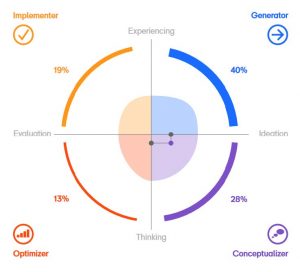Basadur Innovation Profile

Website
Harvard Business Review
4 Types of Innovators Every Organization Needs
by Andy Wu, Goran Calic, and Min Basadur
Languages Available
- English
- English (grade 7-12)
- Arabic
- Chinese (Simplified)
- Chinese (Traditional)
- Danish
- Finish
- French
- German
- Japanese
- Korean
- Norwegian
- Polish
- Portuguese (Brazil)
- Portuguese (Portugal)
- Russian
- Spanish
Contact
MILO Business Development
Summary
The Basadur Profile is a proven assessment tool validated by research that provides insight into how people and teams prefer to think during the innovation process, which can be described in 4 stages: generating, conceptualizing, optimizing, and implementing. By identifying these preferred styles, team members can develop a more open mind to their perception of others as well as the various mindsets required to be successful in innovation.
Some people’s strengths lie in initiating new projects and opportunities, whereas others are at their best when defining and understanding new initiatives. For some it’s about producing concrete solutions and turning ideas into workable reality, while others enjoy finishing things off and taking action to make things happen. The Profile identifies these different styles and creates four corresponding categories: Generators, Conceptualizers, Optimizers, and Implementers.
Generators are skilled at initiating, information gathering, and identifying opportunities. They tend to see things from different perspectives and prefer to generate new ideas rather than evaluate existing ones. Conceptualizers like to define problems and generate ideas. They are adept at forming connections and articulating integrated explanations from high-level observations and connections they identify. Optimizers are comfortable turning abstract ideas into practical solutions and are adept at evaluating information to point out faults. They are confident making evaluations and selecting solutions. Implementers enjoy getting things done and excel at adapting to specific circumstances. They are comfortable taking risks and learn through experience.
Advantages
- Identify team strengths and areas for improvement or additional resources
- Increase self-awareness and appreciation for the strengths and abilities of other team members
- Improve collaboration efficiency and success
Applications
- Team building
- Talent evaluation
- Brainstorming

